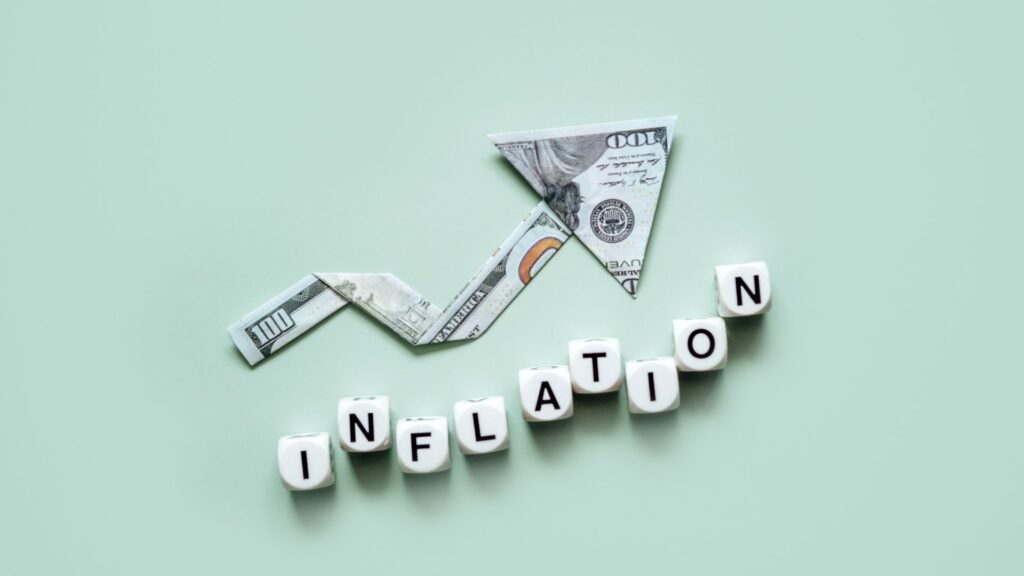
Inflation is a term that frequently arises in discussions about economic health, personal finance, and investment strategies. Its effects can have a profound impact on individuals’ financial health and long-term wealth accumulation. As prices for goods and services rise, the purchasing power of money diminishes, influencing everything from everyday expenses to retirement savings. This comprehensive article explores the concept of inflation, its causes and effects, and why long-term investing is a crucial strategy to mitigate its adverse impacts.
What Is Inflation?
Inflation refers to the general increase in prices and the fall in the purchasing value of money over time. It is a critical economic indicator that impacts consumers, businesses, and policymakers alike. Typically measured by the Consumer Price Index (CPI), inflation reflects the price changes of a basket of consumer goods and services, including food, clothing, housing, transportation, and healthcare.
Understanding Inflation Metrics
- Consumer Price Index (CPI): The most commonly used measure of inflation, the CPI tracks changes in the prices of a specified set of goods and services over time. It reflects the cost of living and is often used by governments to adjust salaries, pensions, and social security payments.
- Producer Price Index (PPI): This index measures the average changes in prices received by domestic producers for their output. It can be an early indicator of inflation as it reflects the prices before they reach consumers.
- Core Inflation: This measure excludes volatile items such as food and energy prices, providing a clearer picture of long-term inflation trends. Central banks often focus on core inflation to inform monetary policy decisions.
Types of Inflation
Inflation can manifest in several forms, each with its unique causes and implications:
- Demand-Pull Inflation: This type occurs when demand for goods and services outstrips supply. Factors such as increased consumer confidence, lower interest rates, or government stimulus can drive demand, leading to price increases.
- Cost-Push Inflation: Cost-push inflation arises when the costs of production increase, causing producers to raise prices to maintain profit margins. This can happen due to rising wages, increased costs for raw materials, or supply chain disruptions.
- Built-In Inflation: Also known as wage-price inflation, this type occurs when businesses increase wages to attract workers, and those increased labor costs are passed on to consumers in the form of higher prices. This creates a self-perpetuating cycle of rising wages and prices.
Causes of Inflation
Understanding the root causes of inflation can help consumers and investors prepare for and react to changing economic conditions. Key factors include:
- Monetary Policy: Central banks, such as the Federal Reserve in the U.S., influence inflation through their control of interest rates and money supply. For example, when a central bank lowers interest rates, borrowing becomes cheaper, encouraging spending and investment, which can lead to increased demand and, consequently, inflation.
- Fiscal Policy: Government spending and tax policies can also impact inflation. Increased government spending, especially during economic downturns, can stimulate demand and contribute to inflation.
- Supply Chain Disruptions: Events such as natural disasters, geopolitical tensions, and pandemics can disrupt supply chains, leading to shortages of goods and increased prices. The COVID-19 pandemic, for example, caused significant supply chain disruptions that contributed to rising prices.
- Consumer Behavior: Shifts in consumer confidence can influence spending patterns. When people feel optimistic about the economy, they tend to spend more, leading to higher demand and prices. Conversely, during economic uncertainty, consumers may cut back on spending, which can lower inflation.
The Impact of Inflation
Inflation has far-reaching effects that can influence various sectors of the economy and the daily lives of individuals:
- Purchasing Power: As inflation rises, the value of money decreases, meaning consumers can buy less with the same amount of money. For instance, if inflation is 3% annually, something that costs $100 today will cost $103 next year, eroding purchasing power.
- Savings and Investments: Traditional savings accounts often offer low-interest rates that may not keep pace with inflation. For example, if a savings account yields 1% interest but inflation is at 3%, the real value of savings diminishes, leading to a loss of purchasing power over time.
- Interest Rates: In response to rising inflation, central banks may increase interest rates to cool down the economy. While this can help manage inflation, it also raises borrowing costs for consumers and businesses, potentially slowing economic growth.
- Wages and Employment: Inflation can impact wage growth. In periods of high inflation, workers may demand higher wages to keep up with rising prices. However, if businesses are unable to pass these costs onto consumers, it may lead to reduced hiring or layoffs.
Why Long-Term Investing Matters
Given the erosive effects of inflation, long-term investing becomes crucial for wealth preservation and growth. Here are several reasons why investing for the long term is essential in an inflationary environment:
1. Compound Interest
Investing over a long period allows individuals to take advantage of compound interest, which is the process of earning interest on both the original investment and the accumulated interest over time. The longer your money is invested, the more it can grow exponentially.
- Example: Suppose you invest $1,000 at an annual interest rate of 6%. After one year, you would have $1,060. In the second year, you earn interest not just on the original $1,000 but also on the $60 earned in the first year. After 30 years, this investment would grow to approximately $5,743, demonstrating the power of compounding.
2. Equities Outperform Inflation
Historically, equities (stocks) have provided returns that outpace inflation over the long term. While stock prices can be volatile in the short term, they tend to rise over extended periods as companies grow, innovate, and generate profits.
- Historical Data: The average annual return of the S&P 500 has been around 10% over the past century, significantly outpacing the average inflation rate, which has hovered around 3%. This long-term growth potential makes equities a vital component of a long-term investment strategy.
3. Real Assets as a Hedge Against Inflation
Investing in real assets, such as real estate or commodities, can serve as a hedge against inflation. These assets tend to increase in value when inflation rises, providing a buffer against the erosion of purchasing power.
- Real Estate Example: Properties often appreciate in value over time, and rental income can increase with inflation, providing investors with both capital appreciation and income generation.
- Commodities: Investments in commodities like gold, oil, and agricultural products tend to perform well during inflationary periods, as their prices generally rise along with inflation.
4. Inflation-Protected Securities
Certain investments are designed to protect against inflation. Treasury Inflation-Protected Securities (TIPS) in the U.S. adjust their principal value based on inflation, ensuring that investors maintain their purchasing power. Similar products are available in other countries, making them a valuable component of a long-term investment strategy.
- TIPS Example: If you buy a TIPS bond with a principal value of $1,000 and inflation rises, the principal may increase, ensuring that your investment keeps pace with rising prices. If inflation is 3% in a given year, the adjusted principal would increase to $1,030, protecting your investment.
5. Diversification to Mitigate Risks
A long-term investment strategy allows for diversification across asset classes, which can mitigate risks associated with inflation. Different assets react differently to economic conditions, and a well-diversified portfolio can help manage overall risk.
- Asset Classes: Including a mix of stocks, bonds, real estate, and commodities can provide stability in times of inflation. For instance, while stocks may be volatile in the short term, bonds can provide income and stability, and real estate may appreciate.
Building a Long-Term Investment Strategy
To effectively invest for the long term in an inflationary environment, consider the following steps:
1. Start Early and Invest Regularly
The earlier you begin investing, the more time your money has to grow. Starting early allows you to take advantage of compound interest and ride out market volatility.
- Dollar-Cost Averaging: Consider using a dollar-cost averaging strategy, where you invest a fixed amount regularly, regardless of market conditions. This approach can reduce the impact of market fluctuations and lower the average cost of your investments over time.
2. Set Clear Goals
Establishing clear financial goals will guide your investment strategy and help you choose the right investment vehicles. Goals can range from saving for retirement, a child’s education, or a home purchase to building a nest egg for future needs.
- Time Horizon: Consider the time frame for each goal. Short-term goals may require more conservative investments, while long-term goals can afford to take on more risk for potentially higher returns.
3. Stay Informed and Flexible
Stay updated on economic trends and be prepared to adjust your investment strategy as necessary. Market conditions and inflation rates can change, so being flexible is key to long-term success.
- Review and Rebalance: Regularly review your portfolio to ensure it aligns with your goals and risk tolerance. Rebalancing your investments can help maintain your desired asset allocation.
4. Consult Financial Advisors
If you’re uncertain about where to begin or how to manage your investments, consider consulting with a financial advisor. They can help you develop a tailored investment plan that aligns with your financial situation, goals, and risk tolerance.
- Professional Guidance: A financial advisor can provide insights into market trends, investment strategies, and help you navigate complex financial decisions, ensuring that your investments are well-positioned to combat inflation.
Conclusion
Inflation is an economic reality that can erode the value of money over time, significantly impacting financial planning and investment strategies. Understanding its implications is crucial for effective financial management. Long-term investing emerges as a powerful tool to combat inflation, enabling individuals to grow their wealth and maintain purchasing power. By starting early, investing regularly, and diversifying portfolios, investors can navigate the challenges of inflation and secure their financial futures. In an unpredictable economic landscape, the importance of long-term investing cannot be overstated—it’s a strategy that pays dividends both literally and figuratively, offering a path to financial stability and growth in the face of inflationary pressures.



